Indian Art
15 Most Famous Raja Ravi Varma Paintings
Raja Ravi Varma, one of the most celebrated Indian painters of all time, is known for his realistic depictions of Hindu gods and goddesses, as well as his portraits of Indian nobility. Raja Ravi Varma paintings have become iconic and are considered masterpieces of Indian art. His paintings are famous not only in India but also around the world.
In this article, we will explore the top 12 famous Indian paintings of Raja Ravi Varma, highlighting the unique elements and stories behind each piece. From the iconic “Shakuntala” to the powerful “Draupadi Disrobed,” these paintings are a testament to the artist’s skill and legacy.
Who is Raja Ravi Varma?
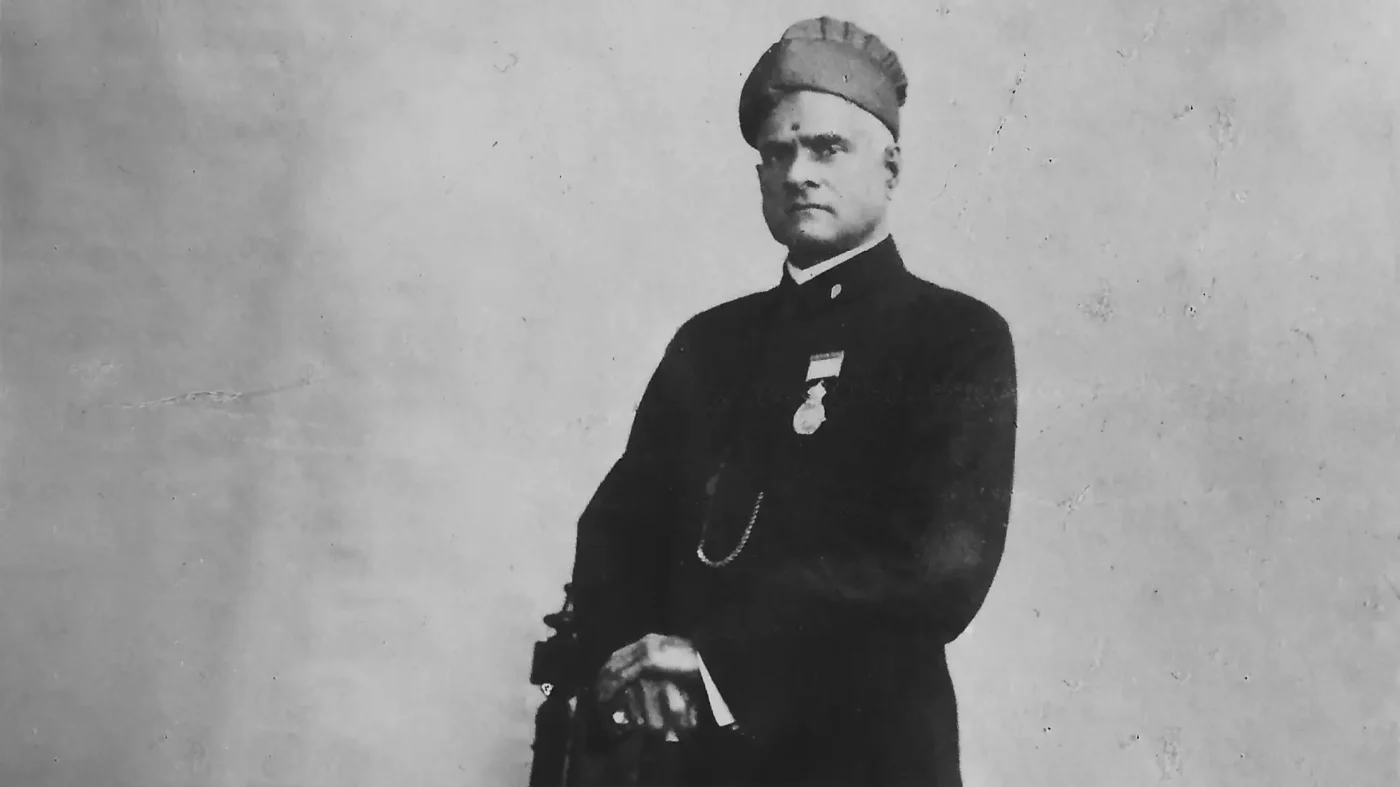
Raja Ravi Varma (29 April 1848 – 2 October 1906 ) was a 19th century Indian painter who is considered one of the greatest painters in the history of Indian art. He is known for his depictions of Hindu gods and goddesses, as well as for his portraits of Indian nobility and British colonial officials.
He was also a master of the traditional Indian painting style known as Raja Ravi Varma is known for his realistic depictions of Hindu deities and episodes from the Indian epics. He also painted portraits of Indian princes and British colonial officials.
He was one of the first Indian painters to successfully combine European techniques with traditional Indian themes. His paintings are widely recognized as a fusion of Indian and European styles.
Here are top 15 Raja Ravi Varma Paintings
Raja Ravi Varma is one of the most renowned Indian painters of the 19th century. He is considered to be the father of modern Indian art, and his paintings are known for their realistic portrayal of Indian mythology and everyday life. The following is a list of 15 of his most famous paintings:
1. Shakuntala (1898)

Raja Ravi Varma painting “Shakuntala” is considered one of his most famous works. The painting depicts the scene from the Indian epic “Mahabharata” where Shakuntala, a beautiful and virtuous woman, is shown receiving a letter from her lover, King Dushyanta.
The painting is known for its sensuous and realistic portrayal of the characters, as well as its use of vibrant colors. The painting is considered a masterpiece of Indian art, and is highly valued for its historical and cultural significance. It is said that Raja Ravi Varma was able to successfully capture the essence of traditional Indian art and culture in this painting.
2. Hamsa Damayanti (1899)
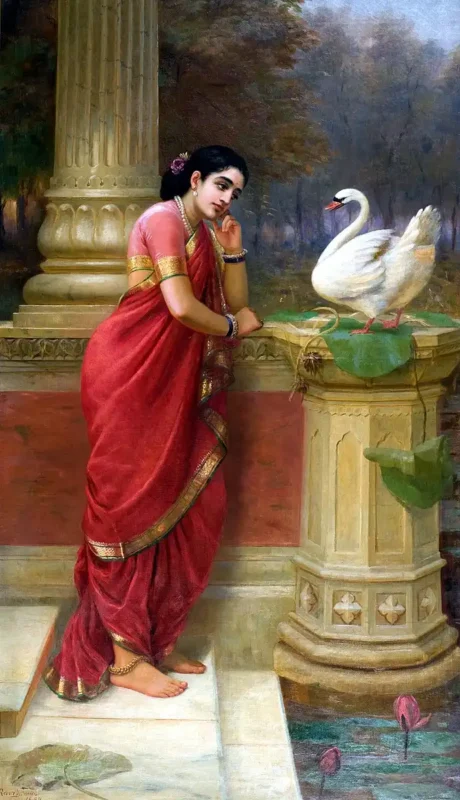
“Hamsa Damayanti” is an oil painting on canvas by Raja Ravi Varma, created in 1899. The painting depicts the story of Damayanti and King Nala from the Sanskrit epic, Nala and Damayanti. The painting is considered one of Raja Ravi Varma’s most famous painting, known for its realistic portrayal of the characters, its ability to convey the emotions of the scene, and its harmony of elements.
According to the story, Damayanti and King Nala fall in love with each other after hearing about their respective noble traits, intelligence and beauty. Using a golden swan as a messenger, they exchange messages. The painting shows Damayanti and King Nala in an intimate moment, holding hands and looking at each other with love and devotion.
Raja Ravi Varma was known for his ability to bring out the emotions in his works, and this painting is no exception. The intimate moment between Damayanti and King Nala is portrayed with great sensitivity and realism, and the details of the clothing, jewelry, and surroundings add to the beauty of the scene.
3. The Milkmaid (1904)

Raja Ravi Varma’s “The Milkmaid” is one of his most famous and iconic paintings. “The Milkmaid,” painted in 1904, is a remarkable artwork that showcases a serene and captivating portrayal of a sari-clad Indian woman. This masterpiece skillfully captures the grace and beauty of the subject, with meticulous attention to the details of her attire, especially the flowing folds of the sari. The play of light and shadow on the woman’s face and clothing adds depth and realism to the scene, enhancing its overall aesthetic.
This painting offers a glimpse into the daily life of a middle-class Indian woman during the early 20th century, presenting a harmonious fusion of traditional Indian elements with European artistic techniques, making it a timeless representation of cultural and artistic synthesis.
4. Damayanti (1895)
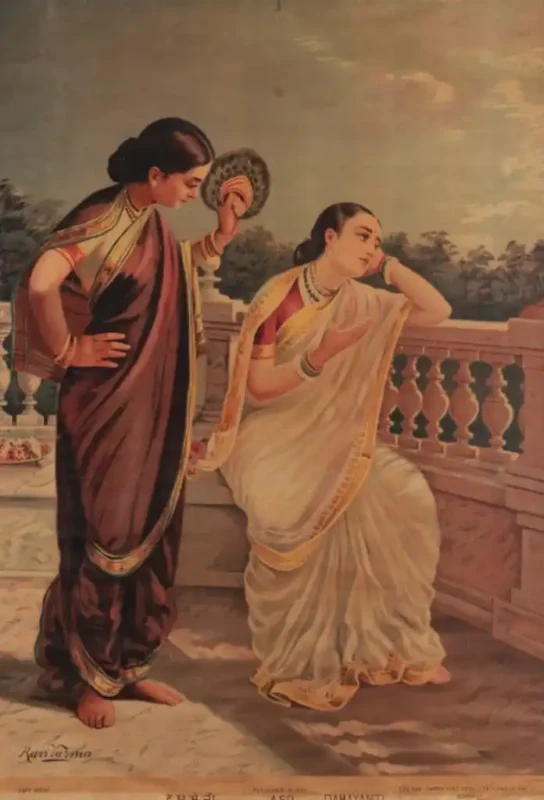
Raja Ravi Varma is a famous Indian painter known for his works that portrayed scenes from Indian mythology and epics. One of his most famous paintings is “Damayanti,” which depicts a scene from the Indian epic Mahabharata. Damayanti is the daughter of Bhima, the king of Vidarbha.
The painting shows Damayanti, a beautiful and virtuous queen, being presented with a choice between four suitors, including the god of love, Kama. She chooses her husband, King Nala, who is hidden among the suitors. The painting illustrates Damayanti’s beauty and her devotion to her husband. This painting is considered a masterpiece of Indian art and is widely admired for its use of vibrant colors and realistic details.
5. There Comes Papa (1893)

“There Comes Papa” is one of the most famous paintings by the Indian artist Raja Ravi Varma. The painting, created in 1893, depicts a scene of a father returning home to his children. The painting shows Varma’s daughter (Mahaprabha Thampuratty) and grandson (Marthanda Varma), looking towards the left at an approaching father. The children are depicted with expressions of joy and excitement, eagerly awaiting their father’s return.
The painting is known for its realistic portrayal of the human form, attention to detail and the use of vibrant colors. Raja Ravi Varma was a master at capturing the emotions of his subjects, and “There Comes Papa” is a perfect example of this. The painting is considered a masterpiece of Indian art and is considered a representation of the cultural and social values of India.
Raja Ravi Varma was a celebrated Indian painter of the late 19th and early 20th centuries, and “There Comes Papa” is one of his most famous works. It continues to be widely admired and enjoyed today, and is considered a classic of Indian art.
6. Stolen Interview (1906)

“Stolen Interview” is a painting by Raja Ravi Varma that was created in 1848 – 1906 (the exact year is unclear) and is currently housed at the Salar Jung Museum. The painting depicts a romantic scene of a couple standing beside a pillar in a garden. The woman is holding a rose and plucking its petals, while the man is resting his cheek on his left hand and looking at her with an expression of anxiety.
The painting is noted for its use of vibrant colors and attention to detail. Raja Ravi Varma was a master at capturing the emotions of his subjects and “Stolen Interview” is a perfect example of this. The painting conveys the sense of anticipation and longing that the man feels as he watches the woman pluck the petals of the rose. The woman’s actions with the rose may symbolize the uncertainty of their relationship.
Raja Ravi Varma was a celebrated Indian painter of the late 19th and early 20th centuries and “Stolen Interview” is one of his most famous works. It is admired for its skillful composition and the ability to convey the emotions of the characters. The painting is considered a masterpiece of Indian art and is considered a representation of the cultural and social values of India in the late 19th century.
7. Galaxy of Musicians (1889)

“Galaxy of Musicians” is a painting by the Indian artist Raja Ravi Varma that shows a group of Indian women from various backgrounds playing their traditional instruments. The painting depicts a diverse group of women, including a Muslim courtesan, a Nair woman playing a veena, and a Marathi woman at the center, all dressed in their traditional attire. The painting emphasizes the customs and adornments of women from different regions of India, showcasing the diversity and richness of Indian culture.
The painting was originally created for the Maharaja of Mysore, and it is a great representation of the cultural and social values of India in the late 19th century. Raja Ravi Varma’s focus on each group’s customs and how they all characterized music in this painting is remarkable. The painting is known for its use of vibrant colors, attention to detail, and the realistic portrayal of the human form. It is considered a masterpiece of Indian art and a representation of the diversity of Indian culture.
Raja Ravi Varma was a celebrated Indian painter of the late 19th and early 20th centuries, and “Galaxy of Musicians” is one of his most famous works. It continues to be widely admired and enjoyed today and is considered a classic of Indian art that showcases the diversity and richness of Indian culture.
8. Maharani Lakshmi Bayi (1883)

Maharani Lakshmi Bayi was a significant historical figure in India. She was the Senior Rani of Travancore, a state in southern India, from 1857 to 1901. She was adopted into the Travancore royal family and went on to become the Senior Rani. She was the sister of Raja Ravi Varma’s wife. She married Kerala Varma Valiya Koil Thampuran, who was also referred to as Kerala Kalidasa due to his translations of works of the famous Indian poet Kalidasa into Malayalam.
During her reign, she made significant contributions to the development of education and social reform in Travancore. She established schools for girls and also provided education to women of all castes. She also established the Sree Mulam Praja Sabha, which was the first democratic assembly in India and abolished certain social practices that were considered discriminatory.
Maharani Lakshmi Bayi was a powerful and influential figure in Travancore, and her contributions to the development of education and social reform continue to be remembered and celebrated today. Her close relationship with Raja Ravi Varma and her brother-in-law connection with him, had made her an important figure in the cultural history of Travancore and India.
Our Newest Arrivals
-
18th Century Old Lady Oil Painting – Hand Painted Oil Modern Art
₹15,000.00 -
A Lady Riding A Blue Roan Kota Style Miniature Painting – Hand Painted Miniature Art
₹9,999.00 -
A Mughal Lady Miniature Painting – Hand Painted Mughal Shaili Miniature Art
₹4,599.00 -
A Young Girl Holding A Lamb Oil Painting – Hand Painted Oil Modern Art
₹15,000.00
9. Kirat Billi (1895)

“Kirat Bhilli” is a painting by the Indian artist Raja Ravi Varma, it depicts a scene from the Mahabharatha, an ancient Indian epic. The painting shows the sportive forms of Lord Shiva and Parvathi as jungle folk, in the form of a hunter and huntress. The painting is based on an episode in the Mahabharatha where Arjuna, one of the key characters, engaged in severe penance in order to receive the Pashupatastra, a powerful weapon, from Lord Shiva.
In the painting, Shiva is depicted as a hunter with two arms carrying a trident and shield, while Parvathi is also attired as a huntress holding a bow with a quiver of arrows on her back. The painting captures the emotions of the characters and is known for its use of vibrant colors and attention to detail. Raja Ravi Varma’s ability to bring the mythological characters to life and make them relatable to the common people is evident in this painting.
10. Savitri (1898)

“Savitri” is a painting by the Indian artist Raja Ravi Varma that depicts a scene from Indian mythology. The painting shows the story of Savitri, the daughter of King Ashwapati and his queen Malati, who met and fell in love with Satyavan, a prince who had lost his kingdom and was living as a woodsman in the forest with his father.
The painting captures the moment when Savitri, who had undertaken a fast, argued and dissuaded Yama, the god of death, from taking Satyavan’s life. It depicts Savitri in a powerful and determined stance, with Satyavan sitting on her lap. Yama is seen as an ethereal character in the foreground, emphasizing the transcendental nature of the scene.
The painting is known for its use of vibrant colors and attention to detail. Raja Ravi Varma’s ability to bring the mythological characters to life and make them relatable to the common people is evident in this painting. It is considered a masterpiece of Indian art and a representation of the cultural and social values of India. Savitri’s character is often depicted as an embodiment of devotion, love and sacrifice, which are values that are highly regarded in Indian culture.
11. Shakuntala Janm (1890)

Raja Ravi Varma’s painting “Shakuntala Janm” is based on this story of the birth of Shakuntala in the Indian epic poem “Mahabharata.” The painting shows the moment of Shakuntala’s birth, with the apsara Menaka holding the baby, surrounded by Hindu gods and goddesses. The painting does not depict the later scene where Menaka leaves the baby on the banks of the river and Sage Kanva raises her as his own.
Raja Ravi Varma’s painting captures the beauty and grace of the moment of Shakuntala’s birth and the divine presence of the gods and goddesses who have come to witness it. It is considered a classic example of Ravi Varma’s skill as a painter, and his ability to combine traditional Indian elements with a realistic style.
12. Lady Making A Garland (1895)
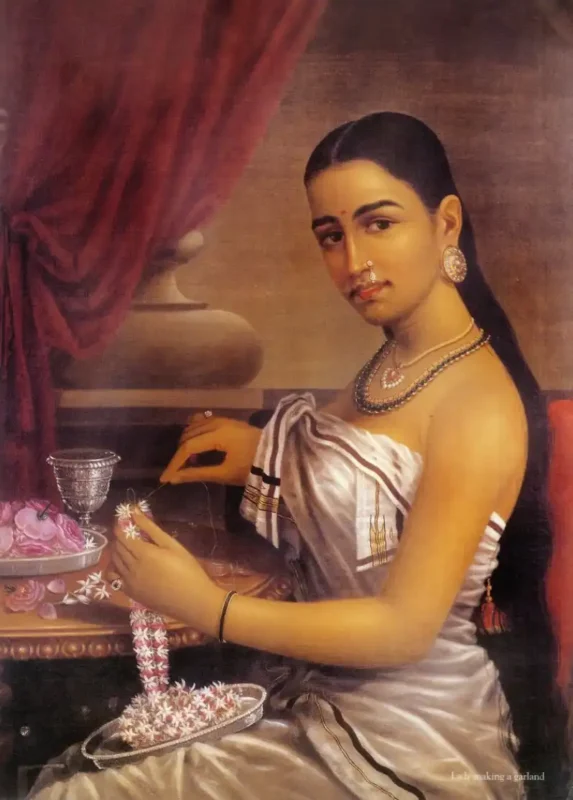
Raja Ravi Varma was known for his paintings of Nair women, who were a prominent community in the state of Kerala where he was from. He often depicted them in traditional attire, engaged in everyday activities such as weaving garlands of jasmine flowers. These paintings were highly popular and helped to establish Ravi Varma as a leading painter of his time. Many of his paintings of Nair women were reproduced as lithographs, which helped to spread his fame throughout India.
Raja Ravi Varma paintings of Nair women were notable for their realistic portrayal of the human form and their use of vibrant colors, which were a departure from traditional Indian art. His paintings of Nair women were also considered an important representation of the culture and lifestyle of the community in the late 19th century.
13. Parsi Beauty (1900)
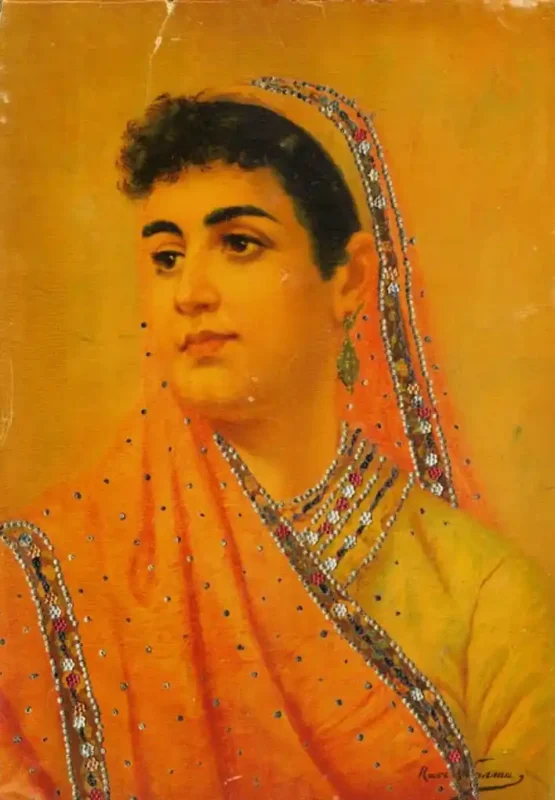
Raja Ravi Varma was known to have patrons from the Parsi community, also known as Zoroastrians. “Parsi Beauty,” is derived from one of Raja Ravi Varma paintings and is an example of his ability to capture the beauty and grace of women from different communities.
Ravi Varma was known for his paintings of Indian women from various communities and regions, such as Nair women from Kerala, and his ability to capture the essence of their culture and customs. This painting is considered a classic example of Ravi Varma’s skill as a painter, and his ability to combine traditional Indian elements with a realistic style.
14. Draupadi Vastraharan (1898)
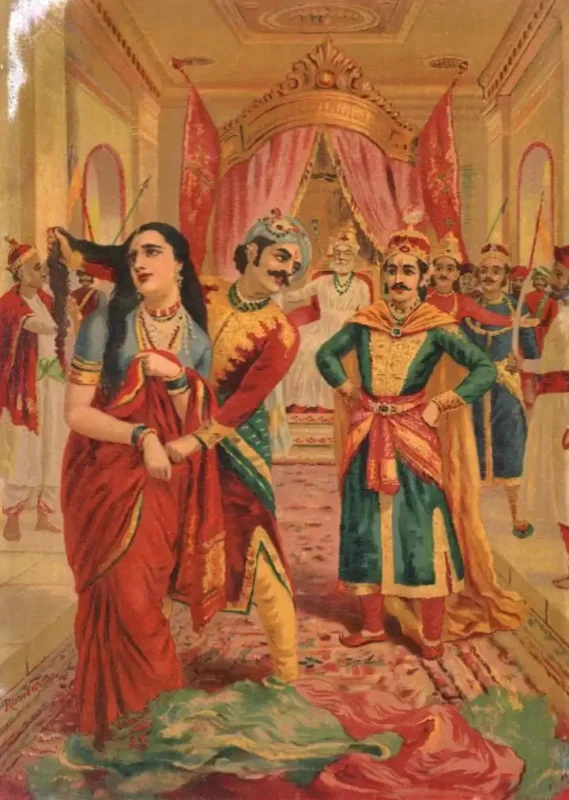
The painting by Raja Ravi Varma you described depicts the scene from the Indian epic, the Mahabharata, in which Draupadi, the wife of the Pandavas, is disrobed by Dussasana in the court of the Kauravas. The painting shows Draupadi in a state of distress as she pleads for mercy, while Dussasana proceeds to disrobe her.
The story goes that a divine intervention occurred, and as Dussasana disrobed her, fresh clothes appeared, and he eventually retired from exhaustion. This scene is considered a significant event in the Mahabharata and is widely depicted in Indian art and literature.
15. Ganga Bhishma (1900)

This painting by Raja Ravi Varma depicts the scene of Ganga fleeing carrying the baby Bhishma in her arms.
This is a story from Hindu mythology about the birth and upbringing of Bhishma, one of the main characters in the epic Mahabharata. The story tells of how Shantanu, a king from the lunar dynasty, fell in love with Ganga and they became husband and wife on the condition that Shantanu would not displease her.
Ganga, who had been cursed by Brahma to be reborn as a mortal, had eight sons and threw seven of them into the river. When Shantanu insisted that the eighth son should not be discarded, Ganga fled the palace with the child, who was later named Bhishma. This event is depicted in a painting by Raja Ravi Varma.
Conclusion
In conclusion, Ravi Varma is considered one of the greatest painters in Indian art history. His paintings are famous not only in India but also around the world. The above-mentioned paintings are some of his most famous works. These paintings are not only beautiful but also hold deep cultural and religious significance. They are considered masterpieces of Indian art and are considered symbols of Indian culture and heritage.


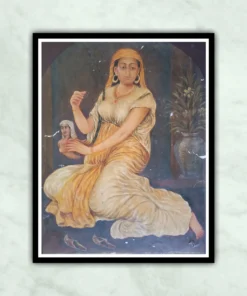



Your blogs are helping me take notes… Thank you very much 😊💛
Thankyou so much ♥️
Very nice study ❤️
It’s a treasure of Gems.
I have a Ravi Varma painting pearl works one old Saraswathi picture